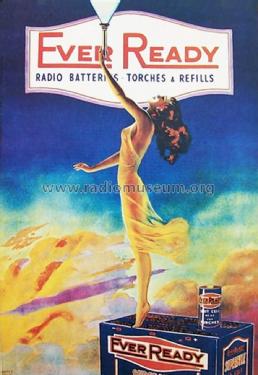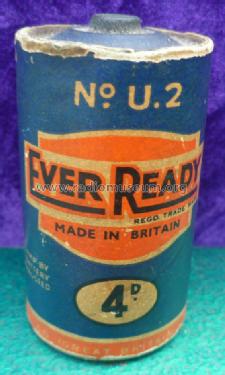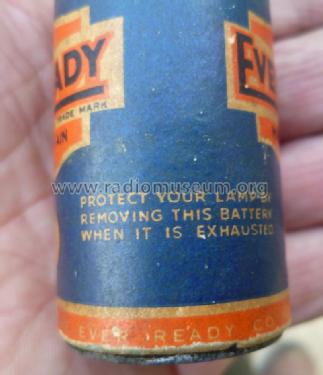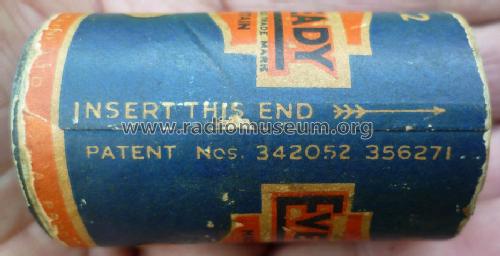Dry Cell Battery U2
Ever Ready Co. (GB) Ltd.; London
- Country
- Great Britain (UK)
- Manufacturer / Brand
- Ever Ready Co. (GB) Ltd.; London
- Year
- 1906 ??
- Category
- Power supply/conditioner or battery or charger
- Radiomuseum.org ID
- 228150
- Wave bands
- - without
- Power type and voltage
- Is a battery or storage battery / 1.5 Volt
- from Radiomuseum.org
- Model: Dry Cell Battery U2 - Ever Ready Co. GB Ltd.; London
- Dimensions (WHD)
- 34 x 61 x 34 mm / 1.3 x 2.4 x 1.3 inch
- Notes
-
Cylindrical Zinc Carbon "D" Cell. Utility Flashlight (Torch) battery from 19th Century. About 6000mAH at low current drain (25mA).
Transistor Radio sets commonly use 4 for 6V. Some models may use 2 or 6. LT for battery valves use 1 (or 2 in parallel) for "Personal" sets and some 1950s models used 5 in series for 7.5V nominal. Many LT or Combo battery packs used these internally. Perhaps at least one HT pack used 80 x U2 (without labels but card dividers). Many Miltary Radios used these as emergency alternates to Rechargeable packs (24V using NiCd "D" size ).
Originally card or paper covered with tar seal at top. Modern versions use a hollow plastic bung, with cheap brands using TWO bungs to save on content! May be the 2nd Dry Cell commercially available.
"Dry Cells" are called "Unit Cells" up till mid 1930s.
- Net weight (2.2 lb = 1 kg)
- 0.1 kg / 0 lb 3.5 oz (0.22 lb)
- Author
- Model page created by Michael Watterson. See "Data change" for further contributors.
- Other Models
-
Here you find 204 models, 146 with images and 92 with schematics for wireless sets etc. In French: TSF for Télégraphie sans fil.
All listed radios etc. from Ever Ready Co. (GB) Ltd.; London
Collections
The model Dry Cell Battery is part of the collections of the following members.
Forum contributions about this model: Ever Ready Co. GB: Dry Cell Battery U2
Threads: 1 | Posts: 2
The Zinc Carbon uses a Zinc case as the negative. The positive is a carbon rod with a cap.
On the Alkaline cells the negative is a disc and the "cap" (positive) is a moulded part of the can.
On modern stuff the battery holder is plastic, so no problems. But older stuff is metal and the Alkaline cell may have only a thin foil covering insulating the positive can from the chassis connected to negative. The foil is easily torn or scraped and then the battery is shorted out. This is particularly a problem on the Philips Annette and similar valve radios with a cut out in the metal chassis for the "D" cell. Here is my solution:
A vintage battery label, two layers of paper and outer clear parcel tape
I had this (actually it was very poor and wrong size, so I edited it a lot):
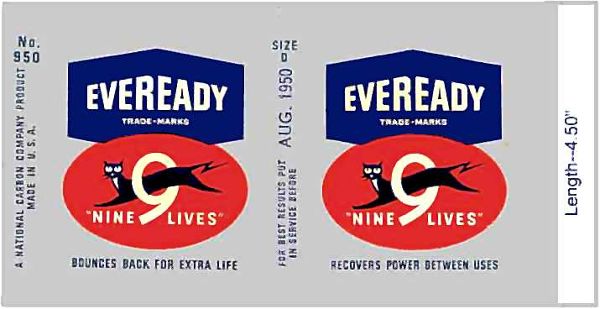
Don't use this, it's the wrong size, use full size in Gallery
And a photo of an old Ever Ready U2. I copy / pasted the logo from a B114 and typed/drew the rest
Download the full size from the Model photo Gallery (On Go to Model link if you can't see it)
Print at 150dpi gives enough ease for thin card, or else use "Pritt/UHU" Stick glue and place while wet so outer slides on inner to avoid wrinkle.
Glue tab on battery (maybe peel off film).
top & bottom should overlap ends, put a little glue around and then fold a small part of overlap rotating the cell each time.
Don't block safety vents on bottom with glue.
Finally cover with clear parcel tape, clear film, or varnish to your choice. A good Zinc Carbon D cell at low current (50mA series chain) may be 6500mAH. Modern ones with two plastic bungs are about 5000mAH or less. At low current a Zinc Chloride is little improvement. An Alkaline D cell may give 12000mAH or more depending on load., about 20% more than an F Cell.
This is a mk1, so the spacing may not be 100% correct. but it looks nicer than brown tape or blank card.
All my designs are deliberately faded to save ink and also not be mistaken for real. You can adjust gamma to make the blue darker to have it more realistic.
Over here I have uploaded a cover for Pertrix Nr 231 for the German Sets :-) which I think is equivalent to a U2 or D Cell.
(P.S. if you don't see the covers, then the article is only just written and the images are not yet approved)
Michael Watterson, 18.Dec.12


